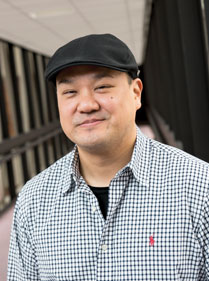 Augsburg College Associate Professor Henry Yoon oversees the biopsychology major and leads the Augsburg Biopsychology Lab. One area of his research involves studying disorders related to the inability to inhibit socially inappropriate or even illegal behaviors such as the use of illicit substances that can lead to addiction. Yoon uses neurophysiological techniques including EEG to capture and analyze the brain’s electrical activity to identify telltale signs of biological or genetic risk for substance dependence.
Augsburg College Associate Professor Henry Yoon oversees the biopsychology major and leads the Augsburg Biopsychology Lab. One area of his research involves studying disorders related to the inability to inhibit socially inappropriate or even illegal behaviors such as the use of illicit substances that can lead to addiction. Yoon uses neurophysiological techniques including EEG to capture and analyze the brain’s electrical activity to identify telltale signs of biological or genetic risk for substance dependence.
Yoon works collaboratively with the StepUP® Program, Augsburg’s residential recovery community, and the University of Minnesota’s Department of Psychology. Ultimately, Yoon’s research may help refine the biological tools used in the diagnosis of substance addiction.
Q:What prompted your interest in studying addiction?
A:Substance use disorders are both common and costly—many of us have personal issues with substance use or know someone who does, including our family members. Plus, addiction is often connected to other major psychiatric disorders in systematic ways. It is important to understand the core factors underlying addiction for intervention and treatment purposes.
Q: One of the brainwaves you focus on—the P3—has been studied in relation to childhood disruptive disorders such as attention deficit hyperactivity disorder, adolescent substance dependence, and adult antisocial behaviors. What’s the link among these areas?
A: Collectively, these disorders reflect a tendency toward behavioral disinhibition, which may be expressed in various ways over development through childhood, adolescence, and adulthood. Evidence shows that this tendency is highly heritable—in other words, influenced by genes. The P3 brain measure is significant because it may signify who is at risk for these disorders. For instance, my colleagues and I showed that P3 is itself highly heritable and can be used to predict who will develop these types of disorders over a 12-year span. So, we reason that the P3 can serve as a red flag.
Q: Despite recognition of the biological and genetic nature of substance use disorders, social stigmas persist. Could improved scientific literacy play a role in reducing these stigmas?
A: I think a cautionary tale from my field’s history can help address this question. In the 1940s-70s, the concept of the “schizophrenogenic mother” was popular in the psychiatric literature. This term implied that mothers who interacted with their children in a cold, rejecting, and aloof manner caused schizophrenia in those children. Another version of this, in relation to autism, was the “refrigerator mother,” which carried a similar implication.
Later scientific research rejected these incorrect and harmful notions and instead showed that such disorders largely involve genetic/biological factors. The same trend can be observed with regard to addiction. For instance, it is now known that substance use disorders are influenced by genetic background to a degree comparable to other complex medical conditions such as diabetes or coronary heart disease. Of course environmental factors are also important, but overall this shows that combating addiction is not a matter of willpower or flawed character.
Online exclusives:
Q: Your research at Augsburg includes volunteers from the StepUP program. How does your work benefit from their participation, and how do students benefit from involvement in your studies?
A: First off, I would like to mention that I am an ardent supporter of the program and feel fortunate that such a program exists in our college community. StepUP participants provide an ideal sample for my studies because these participants were formerly challenged by addiction and thus are presumed to carry the biological or genetic risk for such addiction.
Additionally, since they are currently abstinent, any differences in brain activity compared to those without such an addiction history can be presumed to be due to this biological/genetic risk and not the effects of current use. This is important since if we are able to identify certain brain markers that can tap into this risk, these markers can ultimately be used to better identify others at risk and perhaps even identify those prone to relapse.
Q: What role do you hope your research will play in the future efforts toward treatment for substance dependence?
A: The identification of reliable, objective brain measures that can identify those at risk for addiction or relapse will, of course, be helpful in better identifying individuals for early prevention and intervention strategies. It can also lead to new avenues of research that attempt to uncover the more precise sources in the brain responsible for the abnormal activity—and perhaps offer a better explanation in terms of how they collectively contribute to addiction.




